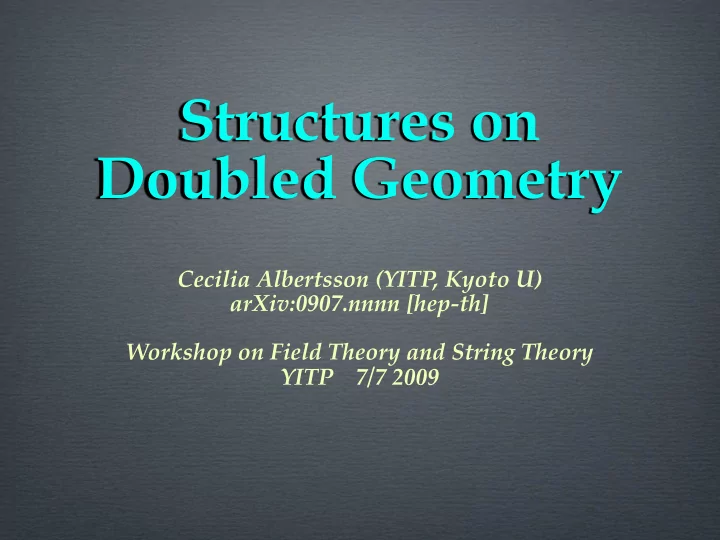

Structures on Doubled Geometry Cecilia Albertsson (YITP, Kyoto U) arXiv:0907.nnnn [hep-th] Workshop on Field Theory and String Theory YITP 7/7 2009
Plan The Problem: T-duality Doubled Geometry Generalised Geometry Comparison Summary
T-duality S = ∫ L String theory: 10 dim Compactify on 6 dim! Real world: 4 dim - S = ∫ L + ... Describe using Generalised Geometry or Doubled Geometry! orbifolds, Calabi-Yau, non-geometric spaces, ... [GG: Hitchin ‘02; DG: Hull ‘04]
T-duality on the internal space! A symmetry of the compactified theory ~ ~ S [ X ] M S [ X ] ~ M internal space T-duality group O(d,d; Z ) toroidal compactifications
⤴ ⤴ ⤴ T-duality on the internal space! ~ X X ~ ~ X ≡ {X,X} ∈ T(M) ⊕ T(M) ~ Π Π original model dual model Doubled Geometry to describe the internal space!
Doubled Geometry ABSTRACT description of the internal space! ~ X X ~ ~ T(M) T(M) v v ~ M M = M not a direct product copy of internal space! internal space!
Doubled Geometry describing the internal space! ● Consider the space Γ \ G ~ ~ ~ ~ T(M) ⊕ T(M) = {v + v ; v ∈ T(M), v ∈ T(M)} ~ X ≡ {X,X} ~ ~ T(M) T(M) v v ~ internal M M space with an O(d,d) structure imposed by a self-duality constraint : P = L -1 M * P
T-duality implemented in Doubled Geometry (describing the internal space!) Sigma model defined on doubled geometry: S = ¼ ∫ M mn d X m ∧ *d X n + ¼ ⅓ ∫ H mnr d X m ∧ d X n ∧ d X r ~ ~ Π where X m = {X μ , X μ } Π ~ ~ S [X] S [X] Mutually dual models are found by: - choosing different coordinate frames T-duality group is in diffeom group: O(d,d) ⊂ GL(2d) ~ - eliminating half of d.o.f, imposing self-duality: dX = *dX
⤴ ⤴ ⤴ Structures on Doubled Geometry Lie algebra structure on Γ \ G [T a ,T b ] = t abc T c neutral metric: signature (d,d) L M positive definite metric ~ almost product structure P = L -1 M * P S ≡ Π - Π T ≡ L -1 M almost product structure J ≡ TS almost complex structure S, T, J satisfy a para-quaternion algebra: J = TS = -ST - J 2 = S 2 = T 2 = 1
Metric compatibility almost para-Hermitian structure L(SX,SY) = -L(X,Y) pseudo-Riemannian almost product L(TX,TY) = L(X,Y) structure L( J X, J Y) = -L(X,Y) almost complex anti-Hermitian structure M (SX,SY) = M (X,Y) Riemannian almost product structure M (TX,TY) = M (X,Y) Riemannian almost product structure M ( J X, J Y) = M (X,Y) almost Hermitian structure
☞ Doubled Geometry is a neutral hypercomplex manifold Neutral metric L Three structures S, T, J satisfying para-quaternion algebra The metrics L and M are twin metrics with respect to T
Generalised Geometry T* p (M) Cotangent space ξ spanned by at point p ∈ M cotangent vectors ξ ∈ T* p (M) , e.g. {dx μ } Tangent space at T p (M) v point p ∈ M spanned by tangent vectors v ∈ T p (M) , e.g. { ∂ / ∂ x μ } p Manifold M internal space
Generalised Geometry describing the internal space! complex geometry: symplectic geometry: structures on T(M) structures on T*(M) T(M) T*(M) T(M) ⊕ T*(M) choice of section complex symplectic geometry geometry
Structures on Generalised Geometry neutral metric: signature (d,d) L M positive definite metric ~ generalised almost product structure (local S ≡ Π - Π split into tangent and cotangent space) T ≡ L -1 M almost product structure Structure group O(d,d)
Comparison Doubled Geometry Generalised Geometry Almost product Almost product structures S and T structures S and T Neutral metric L and Neutral metric L and pos def metric M pos def metric M T-duality group T-duality group naturally encoded naturally encoded
Comparison Doubled Geometry Generalised Geometry Space M is doubled Space M not doubled ~ T(M) ⊕ T(M) T(M) ⊕ T*(M) O(d,d) transition GL(d) transition functions functions Neutral hypercomplex! ~ T(M) ⊕ T(M) T(M) ⊕ T*(M)
Summary - DG is a neutral hypercomplex manifold - Although DG and GG structures are defined on different spaces, there are many similarities - DG appears to be more restricted than GG, but less restricted than Gen Complex Geometry The End
Recommend
More recommend